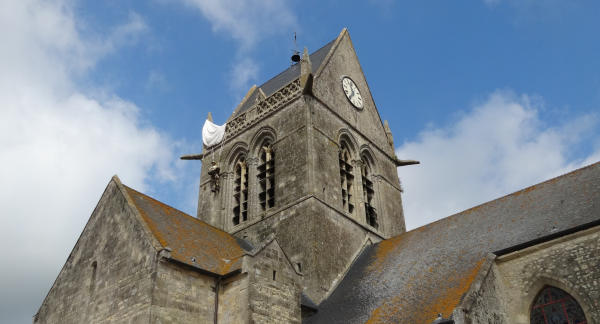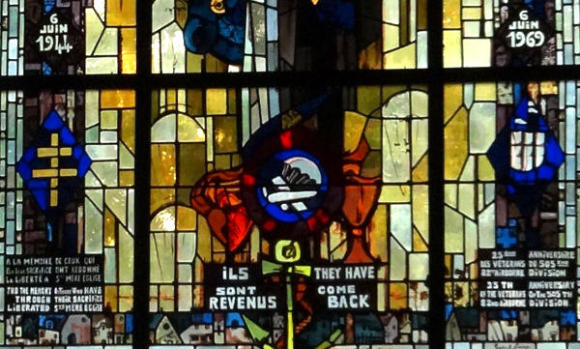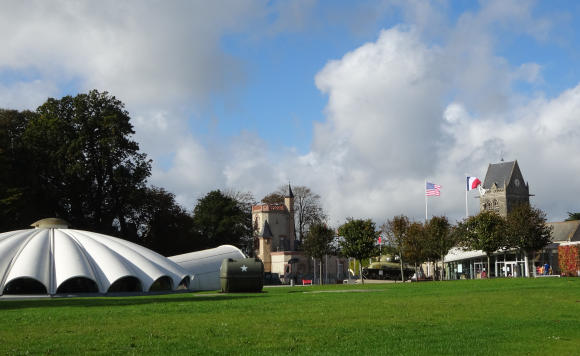
Over the past two years the Airborne Museum in Sainte Mère Eglise, Normandy, created over 50 years ago to commemorate the D-Day airborne landing of the night of June 5-6, 1944, has given Ronald Reagan three places of honor, including a Reagan glorification film that is disturbingly out of place here. In a museum that was never intended to single out just one man, are young visitors, short on knowledge of 20th-century history, being led to believe that Reagan is a freedom-fighter to be revered above those who fought in the Landing Zone? Has the Airborne Museum sold its soul to the Reagan Legacy Foundation in exchange for funding?
* * *
Two films are shown at the Airborne Museum in Sainte Mere Eglise. One of them is among the better introductory films to a visit to the Landing Zone. The other is undoubtedly the worst.
The first, the older one, is a 21-minute documentary that uses a Jaws-like signal of danger as it describes the German occupation, the development of German defenses along the coast, and the civilians’ long wait for liberation. Then the action begins: a fire at midnight destroys the house that stood on the property that is now the museum, people rush from their homes, the fire brightens the night as paratroopers drop from the sky. The beach landing then begins at dawn nearby, battles rage in town, along the country roads and in the hedgerows. They are Americans, to the surprise of many, not English. Lives are lost, freedom is regained, burials take place in what is now the town’s soccer field. The film is short, dramatic and informative, a moving invitation to visit the museum and the sights throughout the Landing Zone.
You may have seen such images and films like this at home; there are plenty on Youtube. But here at Sainte Mère Eglise they take on special significance. In this area where men of the 82nd and 101st Airborne Divisions landed on the night of June 5-6 1944 to secure bridges and roads before the dawn landing of troops on Utah Beach you now stand. A parachute hanging from the steeple of the church across the square lets you know immediately that you’ve arrived at the right place.
After being shown for years in a small screening space in the museum’s second building, behind a Douglas C-47, the type of plane from which the paratroopers were dropped, that 21-minute film was moved in 2016 to a larger space called the Ronald Reagan Franco American Conference Center. The Airborne Museum itself is a non-profit organization. Of the conference center’s €1.2 million construction cost, €350,000 was financed by The Reagan Legacy Foundation.
The Reagan film at the Airborne Museum
The space where the introductory film was previously shown now presents a film glorifying Ronald Reagan. That film is disturbing out of place in this museum.
The older 21-minute film and the newer 7-minute Reagan glorification film (2015) both use 1940s footage to set the stage. Yet whereas the old film shows Eisenhower visiting black-faced Allied troops as they prepare for nighttime assault, the more recent film shows Reagan in make-up and uniform in a Hollywood studio. We are all but told to equate the man playing soldier in Hollywood with the real soldiers in Normandy. An elderly fellow in the film, presented as speaking for all veterans, refers to Reagan as “one of us.”
Without mentioning Franklin Roosevelt, the sitting American president during the Invasion of Normandy, the old film tells about Allies pushing their way to Berlin to defeat a Nazi Germany. The newer film shows Reagan at Pointe du Hoc as though no other president ever honored the veterans and the fallen of the Second World War. It shows Reagan at the Berlin Wall calling on the leader of the Soviet Union “Mr. Gorbachev, tear down this wall,” as though John Kennedy had never stood there. The old film leads curious visitors to want to discover and contemplate the war sites of Normandy. The new film has Michael Reagan, the president’s son, president of The Reagan Legacy Foundation, giving a sales pitch.
Has the Airborne Museum sold its out on its own mission in order to “memorialize the accomplishments of [Reagan’s] presidency,” to quote a goal of the Reagan Legacy Foundation?
The Reagan Triptych
That 7-minute film is one of a triptych of Reagan images that have been strategically placed at the Airborne Museum so that we shall never forget… Ronald Reagan.
1. His name appears on the conference center. So be it, the foundation led by his son Michael provided a third of the funding.
2. In the exit hall of the building called Operation Neptune, opened in 2014, which shows dioramas presenting various scenes from the airborne landing, one sees portraits of German Chancellor Konrad Adenauer and French President Charles de Gaulle, who in 1963 signed the Elysées Treaty in Paris as a firm handshake of reconciliation between the two nations, along with a more prominent and gratuitous image of Reagan 20 years later.
3. And then there’s that film, so intent on placing Reagan, like Forrest Gump (or is it Kim Jong-Un?), at the heat of the action that viewers are led to believe that he would have been a hero on the beaches themselves had he not been… (dramatic pause in the film)… nearsighted.
No, Ronald Reagan was not who my father thought about while in Europe caring for wounded during the war. No, the soldiers did not carry a photograph of Reagan with them into battle. When Eisenhower said to his troops, “The eyes of the world are upon you,” he was not referring to a single man. Normandy is not Reagan’s legacy.
D-Day revisited, again and again
Ronald Reagan was the first American president to commemorate D-Day in France, for it took years for D-Day to be so specifically and particularly commemorated and celebrated. For near 20 years after the war, D-Day and the Invasion of Normandy were largely seen as a step, albeit an important step, in vanquishing Nazi Germany, but requiring no specific commemoration. It took some time for D-Day to gain a singular status in the American consciousness, coalescing our sense of sacrifice for a righteous cause, of honor, strength and the perfect combination of individual and collective effort, and of ultimate victory.
The movie “The Longest Day” was released in 1962. The Airborne Museum opened in 1964, placing it among the first D-Day museums in Normandy, along with the nearby Utah Beach Museum.
As the war receded in time and as many other battles and wars filled newscasts, D-Day—and D-Day above all—became for many the symbol of how we want to see our military might: bringing freedom to the oppressed, supporting and encouraging democracy. D-Day affirms our sense of the United States as the essential nation for forces of good in the world, to the point of diminishing the role of our Allies.
By the late 1960s veterans, then in their 40s, began returning to Normandy to visit the Landing sites, the tombs of their comrades at arm and the new museums. We were sinking into the quagmire of the Vietnam War then. Soldiers who helped turn back the Tet Offensive returned home not to celebration and thanks but to anti-war demonstrations. And June 6, 1944, already gaining prominence over any other date in the war, came further into focus for Americans nostalgic for battles with a clear and righteous cause. The nation that helped bring about D-Day, that was the nation we wanted to be.

More years passed, and in 1984 the 40th anniversary brought together in Normandy, at the invitation of French President Francois Mitterrand, the heads of state of the victorious nations involved in the Invasion of Normandy: Reagan and Pierre Trudeau of Canada, along with Queen Elizabeth II and the monarchs of Luxembourg, the Netherlands, Belgium and Norway. At Pointe du Hoc Reagan shined, with large media coverage, as he spoke with simplicity and force about “the men of Normandy,” “the boys of Pointe du Hoc,” and how “[Europe’s] hopes are our hopes and [Europe’s] destiny is our destiny.”
Stirring indeed, but the facts and images associating Ronald Reagan with D-Day and the Invasion of Normandy are out of context at the Airborne Museum. Visitors may hold Ronald Reagan in the Pantheon of American heroes, if they wish. Savor his words at Pointe du Hoc, if you wish. But why single out Reagan here?
Iraq, Somalia, Afghanistan, Iraq again, Syria, etc. Americans are accustomed to hearing about our military expeditions overseas, yet many continue to see D-Day as our ultimate symbol and pride. Where better place and time to save Private Ryan in 1998 than in Normandy in 1944? President Clinton spoke in Normandy on 50th anniversary of D-Day, Bush on the 60th, Obama on the 65th and 70th, but perhaps the administrators at the Airborne Museum were too busy making doe eyes to the Reagan Legacy Foundation and too nostalgic for the Cold War to bother to look that up what those presidents said.
The evolution of museums in the Landing Zone
I have long appreciated the directness and authenticity (or near-authenticity) of the Airborne Museum. The Waco glider with a “stick” of soldier-mannequins, the Douglas C-47, the uniforms and equipment, the possessions packed in paratrooper bags (Chiclets, Lucky Strikes, condoms). That sense of authenticity recently led the museum to replace a Canadian-made Sherman tank built beginning in August 1944 with a Sherman M4 A4 75 of the type used by the Allies as of June 1944.
Of course it’s no longer enough to present tanks, arms, uniforms and planes and expect visitors understand what went on here. Context and explanations are necessary, but even that may not be enough to keep generations born this side of 1990 or 1980 or even 1970 interested and informed.
In 2014, the 70th anniversary of D-Day and the Liberation of France, I organized in Paris on behalf of France’s Heritage Journalist Association a round-table discussion about the evolution of museums and other war-related business and the potential for the “disneyfication” of the Landing Zone, the temptation to falsify in order to make the Invasion of Normandy seem more real, more entertaining. Magali Mallet, director of the Airborne Museum, was one of the participants. She spoke of the necessity to respond to the evolution of the clientele. (Americans represent less than 10% of the number of visitors to the Airborne Museum, about the same number of Dutch visitors.) The majority of visitors are French, including many school groups.) New visitors, Mallet said, have learned little in school about the events of June 1944 and it was therefore the task of the museum to captivate them through emotion rather than artifacts alone in order to then excite their curiosity and their desire to learn more.

I called Director Mallet after re-viewing the Reagan glorification film this month to ask how she saw Reagan’s role at the museum. She said that his place at the museum is not intrusive on the experience of visiting the museum or of its overall approach to informing the public. Veterans, she said, often say how much appreciate the Reagan film and recall his Pointe du Hoc speech. Reagan’s presence on the museum site is neither promotional nor political, she said.
The sons of David Dewhurst, a squadron commander who led a bombing run over Utah Beach minutes before the landing, have gathered over $2 million to help make the Utah Beach Museum the excellent museum it is today, but you don’t see them claiming that their father saved the day. Mention of Dewhurst and his sons is non-promotional and non-political as can be, that despite one of those sons being Republican lieutenant governor of Texas at the time of the donation.
Normandy was never the place to glorify a single man
From Saint Mère Eglise to Pegasus Bridge, from Falaise to Cherbourg via Caen, Bayeux and the five Landing Beaches, this is an extraordinary region to understand not just D-Day, but the entire war in Europe. More than that, it is a region to consider the nature of alliances and the reconciliation of former enemies, to feel and to reflect on national pride, to meet French, British, Canadian, Polish, Dutch, German and others who are heirs to the events of 1944 and the Second World War. It’s a place to consider the civilian victims of war of yesterday and today. But Normandy is not the place to glorify a single man. It is not the place for the singular hero-worship that the Airborne Museum has bestowed upon Ronald Reagan.
Mrs. Mallet, take down that film.
© 2017, Gary Lee Kraut


I visited Normandy about 3 months ago and was quite unpleasantly surprised but the emphasis placed on the role of Ronald Reagan in the D-Day landings. Almost most as if Ronald Reagan played an active role actually fighting in the war – but he did not.
Whatever the medical constraints the fact is he was stateside during the fighting producing educational and promotional films to help the war effort- which bike self is not a lower task.
The fact remains that Eisenhower was a much more appropriate President to be commemorated and given pride of place at the Museum. Yes, Regan gave a fantastic speech – but that was all.
It was like visiting a church of the Republican party. Even then there are some more appropriate Heroes with correct Republican party antecedent who can be commemorated – George Bush (senior) and John McCain (the father and the son) come to mind.
It was sad viewing, to be honest, for the wilful highjacking of history and forceful appropriating of the memory of the most revered and haloed group of heroes.
Don’t give a s–t about Reagan he was a great president but other than that ok. The tribute should be left to the men who stormed the beaches ans jumped from the c47s men like my grandfather who jumped into this town with the 82nd don’t leave the glory to one man leave it to all who fought this horrid war.
This is so sad. I did meet, many years ago,in Texas, one of the men who were parahuted in and got tangled up in things while being fired on , but it wasn’t Ronald Reagan. He was a modest man and would be horrified by this usurping of glory away from the young men who did the fighting and dying. Unfortunately one gets used to this jingoism (I am a Brit expat living in Texas ) and this was the second annoying example today of an edited version of the truth. All I can do is try to put the record straight when yet again the USA has “The World’s Biggest Pizza” or ” We won the War”.